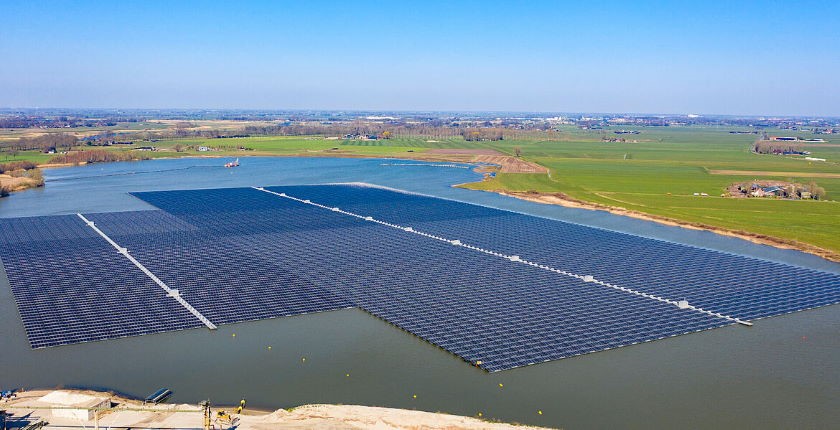The Asia-Pacific region already dominates the fast-emerging market in floating solar PV (FPV), and it looks set to build on that position as more nations get on board and costs fall.
Asia-Pacific is set to increase its market share from 74% in 2020 to 87% in 2026 in terms of global installed FPV capacity.
This year, countries that rank in the top ten for FPV demand will hold 84% of global market share and this is forecast to increase to 86% by 2026, by when Wood Mackenzie expects total worldwide installations could reach 4GW, up from 1.6GW this year. Of these ten countries, eight sit within Asia-Pacific.
China will dominate FPV installations over the next five years, with India and South Korea trailing close behind. Country-level targets, such as China’s carbon neutrality goal, South Korea’s 9th Basic Plan, and India’s 2022 solar installation target, will all contribute to growth in these countries.
China previously faced the challenge of solar production being far from the load. FPV farms have helped to address this issue, with projects being constructed closer to population centres with strong resource availability. With most of China’s population residing in the east of the country, there is a high concentration of FPV farms in this area.
Located in the east, Anhui and Shandong provinces host most of the China’s FPV capacity as of 2020. Good water supply availability, such as flooded coal mines, greatly benefits the technology in the provinces.
New markets
Although Japan currently has the largest number of completed FPV projects of any country globally and will see high growth of FPV installations through 2026, projects are typically smaller and therefore cumulative capacity is less than that of other countries in Asia-Pacific. This is a trend that we expect to continue over the coming years.
In addition to the leaders of FPV in Asia-Pacific, there are several emerging markets to pay attention to, namely Indonesia, Vietnam, Thailand, and Malaysia.
‘People will wonder why they put solar on land at all’: pioneer says floating PV can beat wind
Read more
Lightsource BP international chief says ‘Asia next’ as oil giant unlocks global doors for solar
Read more
The Indonesian government is targeting 23% renewable energy by 2025 and this will heavily contribute to FPV growth over the next five years. Indonesia’s flourishing agricultural industry creates challenges for land-based solar, therefore strengthening the value proposition of FPV in the country.
Vietnam saw huge FPV expansion in 2020, with the country’s FPV market experiencing a year-over-year growth of 150%. The Asian Development Bank is working with the government in Vietnam to roll out solar PV auctions dedicated to FPV. Additionally, the country’s hydropower resource will likely prove to be beneficial for FPV market growth due to the benefits of co-locating FPV applications at hydropower dam reservoirs.
Mainstream challenges?
The challenges facing FPV markets today include successfully balancing system costs with soft costs and unknown risks associated with plant operations.
Overall costs for FPV farms tend to be higher than land-based applications of a similar size and location. This is typically due to high soft costs and structural balance of system costs.
In addition, FPV system costs currently vary by country and site. Japan continues to be the highest cost market with average system costs of $2.68/Wdc in 2021, while India currently has the lowest system costs of $0.78/Wdc. Although there are multiple factors that cause system costs to be high or low within countries, larger projects can typically take advantage of economies of scale for both component and labour costs.
Even though FPV farms are typically more expensive than their land-based counterparts, increased development and an enhanced installation experience will contribute to reduced costs in the future. This will mitigate risk associated with the construction and operations of FPV projects, making it easier to find financing for projects. Some progress on this issue has been made, with average FPV project costs in South Korea and India inching closer to land-based applications of a similar size.
Will hydrogen be the skeleton key to unlock a carbon-neutral world? Subscribe to Accelerate Hydrogen, powered by Recharge and Upstream, and get the market insight you need for this rapidly evolving global market.
As costs continue to fall, solar’s share of power supply will rise and begin to displace other forms of generation, according to recent Wood Mackenzie research. And this will only benefit the FPV market.
FPV installations are much quicker to build than fossil-fuelled power stations and can be ready in a matter of months, while coal, gas, hydro generators, and nuclear plants can take several years to construct. As more countries in Asia-Pacific commit to competitive solar and overall renewable energy targets, FPV will be key to meeting these goals.


Recent Posts
DPIIT promotes green logistics industry
Petronet LNG reports record volumes
TotalEnergies buys stake in wind farm to produce green hydrogen
Ports of Indiana, Port of Antwerp-Bruges partner on green shipping
Bhutan moves towards green transition
GCMD completes biofuel supply chain trials with Hapag-Lloyd
Airbus partners with Avolon on hydrogen aviation
Nuclear power transition more safe option for decarbonisation than coal